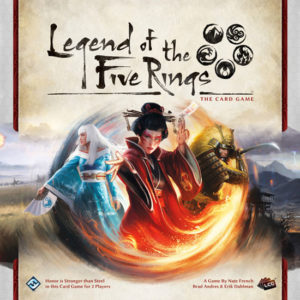 Legend of the Five Rings and its world of Rokugan are one of the most beloved fictional setting in gaming. With eight great Clans and several minor houses clamoring for position to become the Emperor, the mythology is full of military stratagems and posturing, political intrigue, and danger around every turn.
Legend of the Five Rings and its world of Rokugan are one of the most beloved fictional setting in gaming. With eight great Clans and several minor houses clamoring for position to become the Emperor, the mythology is full of military stratagems and posturing, political intrigue, and danger around every turn.
It found success as one of the most successful collectible card games outside of Magic: The Gathering, as well as a role-playing game, amassing a huge following over the years. When Fantasy Flight Games announced that they were planning on reimagining the game as part of their Living Card Game system, both loyal fans and newcomers alike were overjoyed with the news.
Legend of the Five Rings: The Card Game is a ‘living card game’ for two players that takes between 60-90 minutes to play.
Gameplay Overview:
Players construct a deck using cards from one of seven clans, splashing in cards from another clan and generic cards. Each player has four provinces that serve as the staging area for cards coming into play, and are the target for attack by their opponent. Cards on provinces can either be characters, attachments that enhance characters in play, or attachments that enhance the province they are on. Each player also has a stronghold province that provides players with fate tokens each turn and is more difficult to defeat.
Turns of the game follows the following sequence of steps:
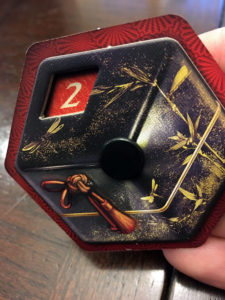
Dynasty Phase: Players turn cards played on provinces face-up, collect fate tokens and bring characters from provinces into play. Character cards enter play by paying their fate cost, with extra fate spent and placed on the cards either to keep them in play for more turns, or to activate card powers.
Draw Phase: Using a dial, players secretly bid how many cards they wish to draw. Players reveal their bids and draw their cards, and whoever bid higher has to pay the difference in honor points to the low bidder.
Conflict Phase: Battles start when a player declares the type of attack (military or political), identifying which province is being attacked, and what element is being used in the attack. After defenders are chosen, players alternate in playing cards from their hand and activating other card powers, with the player with the higher stat claiming victory in the battle. If the attacker wins by a margin greater than the province strength they were attacking, that province is broken. In addition, a victorious attack provides varying rewards for that player (drawing cards, honor points, etc.) depending on which element was selected at the beginning of combat. Each player gets to initiate an attack twice per turn.
Fate Phase: Character cards without fate tokens are removed from play and each character then has a fate token removed from their card.
Regroup Phase: Face-up cards on provinces may be discarded from provinces and all the cards used in the turn are readied.
The game ends when one player attacks and breaks their opponent’s stronghold, when one player gains 25 honor points, or when one player loses their entire honor.

Game Experience:
Legend of the Five Rings has some interesting mechanics integrated into the gameplay. The bidding system for determining the number of cards drawn adds a good amount of strategic tension to the game, by forcing players to balance their own need for cards with their assessment of their opponent’s and own cards in play and the cards in hand. A gross overestimation or underestimation of the board state and associated draw bid can either lead to a wealth of possible card choices in a full hand, or a large transfer of honor from one player to another.
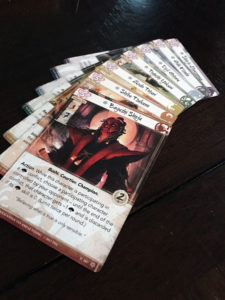
Game tension is added when province cards are targeted for attack. Since they are played face-down and only available for viewing to their owner, their powers are unknown to the attacker and revealed only when they are declared as the target. Upon reveal, provinces activate abilities that can have significant impact on combat, such as providing bonuses and penalties or switching the type of attack (military vs political). It makes attacking an unknown province a bit of a gamble, forcing players to probe their opponent’s defenses before committing an overwhelming attack force.
Unfortunately, while some mechanics may be interesting, they do not support a game that is exciting to play. The gameplay is extremely repetitive, with the above aspects the only bright spots in our experience. Conflict resolution is especially boring, being a simple comparison of attack vs. defense value and the limiter on victory being the person who runs out of actions and cards to play first.
Further, in every game we played, whoever played their ‘champion’ (the strongest character in their deck) first, ultimately was the victor. Finally, in the games we played, breaking the other player’s stronghold was the only path to victory, as the number of honor points gained and lost over the course of the games had no impact on victory. In the end, game play was unsatisfying despite the integration of two interesting mechanics.

The Legend of the Five Rings IP has a vast and detailed mythology, having a history going back to 1995 with a collectible card game and roleplaying game. With influences from all over Asia, the game’s theme is expressed through the card titles, powers, and art. To those with exposure to the world of Rokugan and previous players of L5R, we imagine that the game would be dripping with the theme that would be present throughout gameplay. However, with our limited exposure to the mythology and backstories, we found the characters unfamiliar and uninteresting (but we appreciated the story in the Learn to Play guide nonetheless).
The final, and perhaps greatest, detractor to L5R is the game itself that is provided in the box. With a single box, players simply cannot create complete decks, or even somewhat larger decks that could provide a game experience that is marginally (if not significantly) better than the experience we had. We could not experience a full game with full rules in the way the designers meant for the game to be played, which was exceedingly frustrating. Others have suggested that an easy fix is to purchase another box, or to print out proxies of cards. Neither of these solutions change the fact that the game is, as presented and sold, incomplete. We are sure this led to the negative impressions we had while playing.
Final Thoughts:
Combining a few interesting mechanics and a property with a rich history do not necessarily make a game that is fun and exciting to play. The sampler platter that is provided in the Legend of the Five Rings box does not inspire us to want to order anything else off the menu.
Score: 2.5 Stars – This could possibly be higher, but not with the game that is provided in the box.
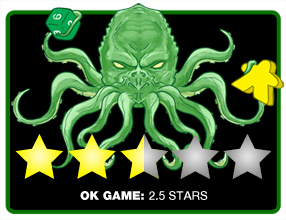 Hits:
Hits:
• Some mechanics that provide tension to gameplay
• Card art, names and keywords help support theme
• Intellectual property provides rich backstory
Misses:
• Incomplete game requires multiple boxes to fully experience
• Unexciting conflict resolution
• Gameplay is tedious and repetitive







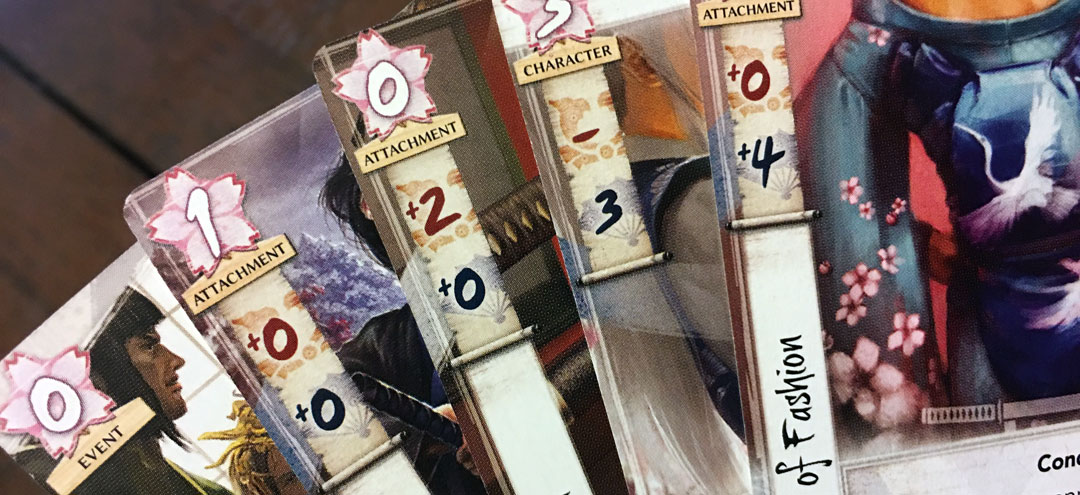















oof.. That’s too bad, I was really hoping this would be another good game in their LCG lineup (like Lord of the rings, Netrunner, and Arkham Horror LCG ) .. Thanks for saving me the monies for now.. I hope they’ll fix that with either a reprint or an expansion
Thanks for the comment! I can only speak to Netrunner and LotR being far superior, and those two games had solid mechanics and provided a fun game experience. Also, they had their own twists, whether it be asymmetric or cooperative play. L5R’s conflict mechanics ended up feeling like a more complex Munchkin or Cutthroat Caverns. Not terribly good at all.
I really hate their business plan – buy 2 boxes to have full game. It’s a big nuisance.
I tried my best to not have this review be an editorial on FFG’s LCG business model, but there’s talk behind the BGQ curtain of an article about that in the near future. For now, all I’ll say is that I’m OK if serious tournament players feel the need to buy multiple boxes to be competitive, but the game should provide a complete experience to any set of players right out of the box. I think this is also what happened with WH40K?
While I agree with the 2 box for full experience (which is as discussed the model FFG is using), the two games I played with one box were really fun and I faced 2 very different decks, one concentrating on raw might the other on using attachments to boost character while my deck was based on dishonor, hence I won both game by bringing my opponent to 0 and never touched the stronghold.
Funnily enough he had his champion out in one of the game but I kept him bowed so he couldn’t use him, the cost of getting him out was also important and gave me an edge in resources.
I didn’t find the combat that boring as there is always a element of surprise if you can bring a card that will turn the tide of battle. There were a few case where I thought I would won the fight easily but when your courtier is sent home and the card you wanted to use are base on him being in the fight, it went from a sure victory to a sure defeat.
Overall I think the game was as fun as netrunner, less asymmetrical but there is a lot of depth in the type of deck you can make. I would put the two on par with each other.
Clarification question: the games you played were with two decks from one box?
The ‘take-that’ aspect of combat can definitely keep the process fresh, but we found that success in battle devolved into a race to who ran out of action options first. Perhaps there is more strategy in picking and choosing your spots, but we didn’t see it in our plays. Also, with the starter decks, the surprise cards were so swingy that it was almost impossible to recover from them.
We didn’t find there to be much depth in deck construction as you appeared to, sadly. We are glad you enjoyed your plays!
The first game was against another player with his core deck, however it was a completely different clan so other than a few neutral card there wasn’t a huge overlap between our decks, the second game was against the owner of the core set so the 2 decks were from the same core set.
I thought the same at first when playing combat but I think it can be more subtle than that, for example I lost some combat on purpose to keep some card for my attacks as you can do one attack of each type and you will defend against maybe two attacks. Keeping resources for one big attack is a valid strategy, I found that let some win wasn’t the end of the world if they can’t break your province. They might commit to much and then be unable to defend. I also watched how much resources they had left to potentially bring in a card in play. So I while I agree that it seemed like you described at first, afterwards I understood that winning wasn’t always necessary and that you can plan different strategy during the combat phase. The thing I found less exciting than I thought first reading the rule was the bidding process for cards, it tends to be fairly close once you have a few game in (draw big the first few rounds, then draw less).
I didn’t build those decks, as I don’t own a core set, I wanted to try it out first, so my friend built that deck for me.
Honestly of the 4 lcg game I tried (LOTR, arkham, netrunner and l5r) I think only the first two are really playable out of one core box, the others two are rather restricted in deck building option and even LOTR is fairly restricted with just the core set, if you play 2/1 color you will tend to take all the card from the main color you have. Arkham being fairly light on deck building anyway is probably the best core value of the 4. Netrunner really fells contrived with one core. So I think this is more to do with FFG policy on this, I think they should have made different core set for 2 or 3 clans to make it more interesting with just buying one core.
This game in my opinion is a nice alternative to netrunner, different flavor and mechanism that are interesting, but I believe it is not to everyone taste (which is fine).